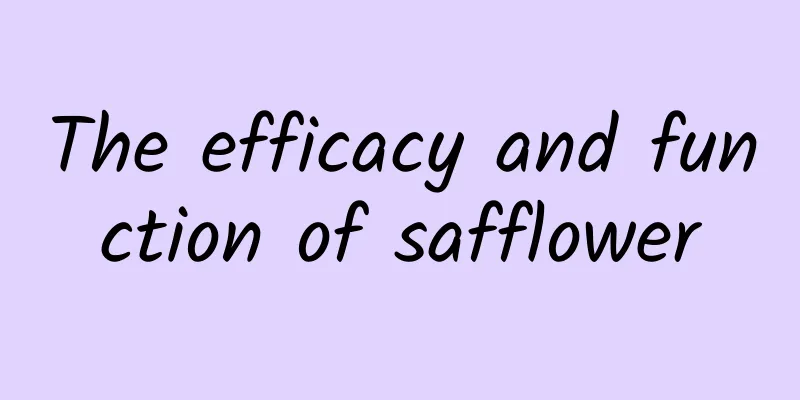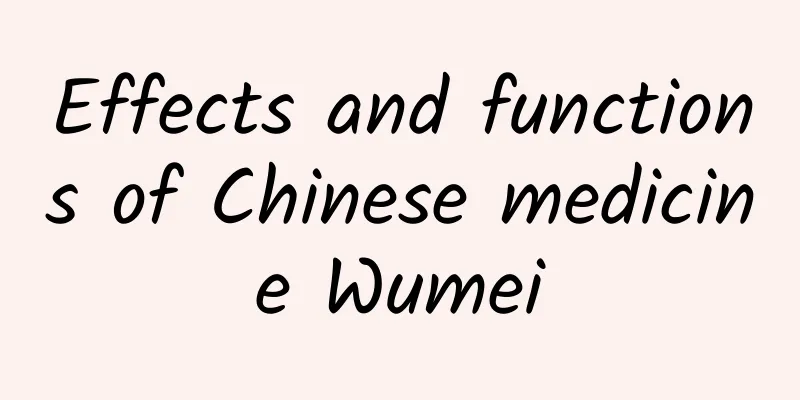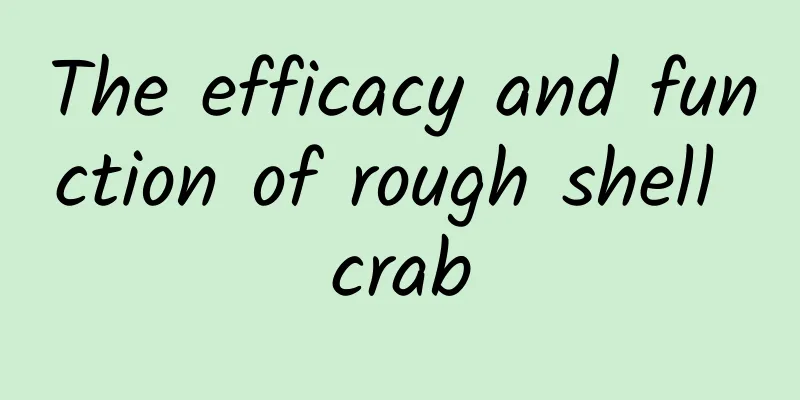The efficacy and function of safflower

|
There are many types of common diseases, so good treatment methods are also needed for the treatment of diseases. Colds and coughs are common diseases. For the treatment of such diseases, cold granules can be selected to improve the disease. What are the effects and functions of safflower? Many people don’t know much about it, and when using such medicines, many people don’t know how to make the medicine work better. So what are the specific effects and functions of safflower? There are many aspects to it. The following is a detailed introduction so that you can have a good understanding of such medicine. You can choose it with confidence in disease treatment and improve the disease. The efficacy and function of safflower: 1.1. Cardioinhibitory effect: A small dose of safflower decoction can slightly excite the isolated heart of a toad and the in vivo heart of a rabbit, making the heartbeat stronger and the amplitude larger; a large dose has an inhibitory effect on the heart, slowing the heart rate, weakening the myocardial contractility, and reducing the cardiac output. 1.2. Experimental studies on coronary blood flow show that: Safflower water extract and safflower water-soluble mixture - safflower yellow pigment can increase coronary blood flow and myocardial nutritional blood flow; while the effect of safflower ethanol extract on dilating coronary arteries and increasing coronary blood flow is not obvious or has no effect. 1.3. Experimental studies on experimental myocardial ischemia and myocardial infarction have shown that: In animal models of experimental myocardial ischemia or myocardial infarction such as rabbits, rats, and dogs, safflower and its preparations have varying degrees of antagonistic effects. Safflower has a significant protective effect on acute myocardial ischemia in rats or rabbits caused by posterior pituitary hormone; it can significantly reduce the degree of acute myocardial ischemia in anesthetized dogs caused by repeated brief blockage of coronary blood flow, reduce the scope, slow down the heart rate, and protect the edge of the acute myocardial infarction area, thereby reducing the scope of infarction and the amplitude of ST segment elevation in the marginal electrocardiogram, thereby improving the supply and demand relationship of oxygen in the ischemic myocardium. 1.4. Research on the effect of safflower on blood vessels found that: For example, if blood vessels are first perfused with Rockwell's solution containing trace amounts of epinephrine or norepinephrine, the animal's isolated vascular smooth muscle will contract and maintain a certain vascular tension, resulting in a state of blood blockage and blood stasis that may be similar to that in humans. Safflower can cause vasodilation in the hind limbs of guinea pigs with increased tension and in the ears of rabbits, and the effect becomes more obvious as the dose increases. Safflower can also increase the blood flow in the femoral artery of anesthetized dogs, but it can cause contraction in normal isolated blood vessels of toads and rabbits. This shows that the vasodilator effect of safflower is related to the functional state of blood vessels and the dosage of the drug. Its mechanism of action may be mainly to directly or partially antagonize the effects of α-adrenergic receptors to cause vasodilation, and it has a weaker direct vasoconstriction effect. 1.5. Effect of safflower on cerebral edema caused by ischemic stroke in experimental animals: A total of 63 Mongolian gerbils were given 10g/kg safflower injection (1ml contains 1g of the crude drug) ip 30 minutes before surgery. A surgical control group and a sham operation group were set up to observe the effect of safflower on ischemic cerebral edema and study the changes in the content of monoamine neurotransmitters in the same brain region. The results suggest that the mechanism by which safflower alleviates ischemic cerebral edema may be related to its ability to affect the metabolic disorders of monoamine neurotransmitters in tissues. It was further confirmed that safflower can indeed reduce the incidence and mortality of stroke, and has a protective effect on the brain tissue of experimental thoracic infarction animals. 1.6. Antihypertensive effect: Safflower decoction, safflower yellow pigment and other preparations have varying degrees of rapid hypotensive effect on anesthetized cats or dogs. The average blood pressure drops by about 20 Hg per minute and recovers after about 30 minutes. 1.7. Experimental studies on the anticoagulant effect of safflower yellow pigment show that: Safflower yellow pigment has a very significant inhibitory effect on ADP-induced platelet aggregation in rabbits, and also has a very obvious depolymerization effect on ADP-aggregated platelets. When the dosage was 0.22 g/ml, the aggregation inhibition rate and disaggregation percentage reached 85.9% and 78.9%, respectively. These effects of safflower yellow pigment are enhanced with increasing dosage. Safflower yellow pigment has a very significant inhibitory effect on experimental thrombosis in rats, with an inhibition rate of 73.4%. Since the material basis of the thrombus formed on the silk thread in the experiment is platelet aggregates, the reduction in the wet weight of the thrombus is obviously the result of the drug inhibiting platelet aggregation. This is consistent with the in vitro experiments that have confirmed that safflower yellow can inhibit ADP-induced platelet aggregation. Safflower yellow pigment can also significantly prolong the plasma recalcification time, prothrombin time and coagulation time of rabbits. This indicates that it can affect the coagulation system both in vivo and in vitro. In addition, safflower oil has the effect of lowering blood lipids. Through the above introduction, we have some understanding of the effects and functions of safflower. Therefore, when choosing such medicines, we can do it according to our own needs. In daily life, people also need to comprehensively protect their bodies. This is also helpful in preventing diseases and preventing harm to the body. |
<<: The efficacy and function of Polygonum multiflorum
>>: The efficacy and function of Magnolia officinalis
Recommend
These stray dogs that were caught for experiments eventually saved countless diabetics
April 24th of each year is Laboratory Animal Day ...
It’s heartbreaking that a woman fell from a building after being cyberbullied. How should we build a “psychological firewall” in the face of verbal abuse?
It’s heartbreaking that a woman fell from a build...
What are the effects and functions of Tibetan Ganoderma lucidum?
Many people don't know much about Tibetan Gan...
When pandas meet bamboo: a "taste revolution" spanning a thousand years
The giant panda is China's national treasure....
After being hit by bird poop, I discovered a "shocking" secret!
Have you ever been hit by bird poop? I don't ...
Today in the History of Science and Technology | 1844·7·3 The last "Arctic penguin" in the world became extinct
180 years ago today, on July 3, 1844, the last pa...
The efficacy and function of tooth edge drilling wind
Glechoma longituba is a common Chinese medicine w...
It's "weight loss season" again! Qin Hao's weight loss diet is exposed. Have you found a scientific way to lose weight?
Can ordinary people imitate Qin Hao's weight ...
Trucks full of hard drives, faster than fiber optic? But times have changed!
Many years later, facing the 20MB/s network speed...
How long is it appropriate to boil Chinese medicine?
Traditional Chinese medicine is a treasure of our...
Do you have dry eyes and feel tired all the time? Do you know what nutrients are needed to protect your eyes?
No. 211 Don't be a muddy world In today's...
To prevent obesity, should you eat like a pig?
You may not believe it, but some scientists sugge...
The most advanced domestically produced "electric car" has a speed of only 0.2 kilometers per hour?
The winning works of the 2023 "China Science...
What are the Chinese patent medicines for removing liver fire?
Spring is the best season to nourish the liver. F...
The efficacy and function of mountain beans
Mountain bean is a very good medicinal material. ...





![The efficacy and function of Perilla frutescens[Picture]](/upload/images/67ca18fca9da7.webp)



